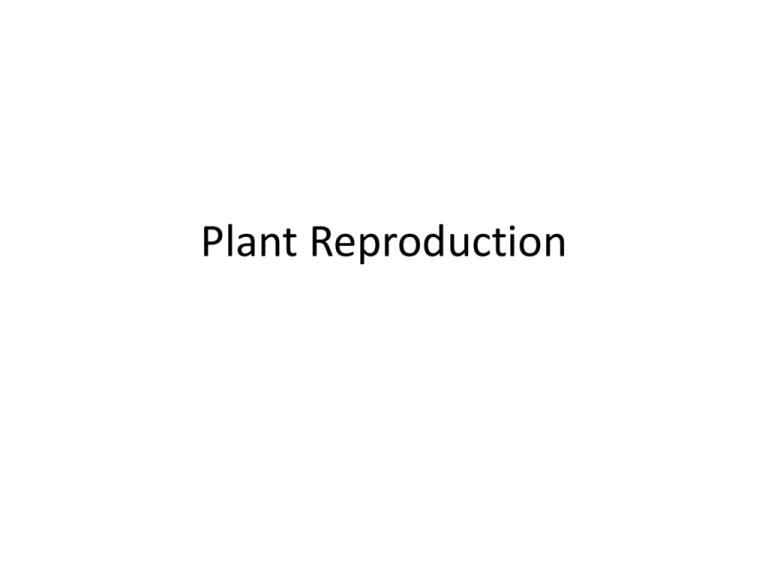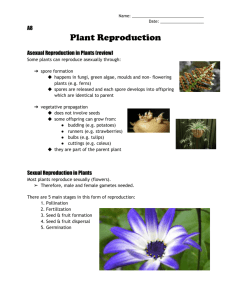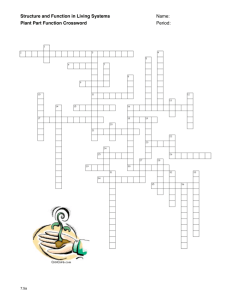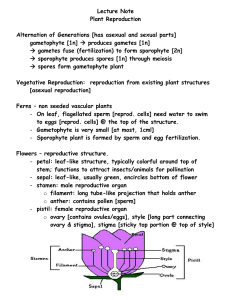File
advertisement

Plant Reproduction • Like all other living things, plants also need to reproduce to produce more plants. • Plants can reproduce asexually or sexually. • Botanists and farmers have been able to interfere in the reproductive process of plants to produce new plants with desirable characteristics. • This has had an impact on diversity and quality plant food production. Reproduction in Nonvascular Plants • Nonvascular plants can reproduce asexually through the process of vegetative reproduction. This occurs when part of the plant breaks off and a new identical plant develops. • Most nonvascular plants reproduce sexually. The male gamete is called an antheridium and it produces a flagellated sperm. The female gamete is called an archegonium and it produces a single egg. • A moist area is needed for reproduction to occur. Water allows the male sperm cells to swim from the antheridium to the archegonium. • The fertilized egg cell divides by mitosis and develops into an embryonic sporophyte within the archegonium. • Most plants have a life cycle that includes a diploid generation, sporophyte, and a haploid generation, gametophyte. • The gametophyte generation is the dominant generation in nonvascular plants. • The sporophyte grows into a long stalk but remains attached to the archegonium. • A sporangium forms at the tip of the long stalk and haploid spores develop through meiosis. • The sporangium bursts and the spores scatter and they germinate by mitosis forming mature gametophytes. Reproduction in Vascular plants • Gymnosperms produce cones that are either male cones or female cones. • Male cones are small and generally found in clusters. • The male cones produce and release haploid pollen cells that resemble yellow dust. • Female cones are also small but are very sticky. • This allows the pollen to adhere to the cone so that fertilization can occur. • When the pollen grain attaches to the female cone, it must travel to the female gametophyte where the archegonium houses the egg cell. • The pollen grain travels to the opening of the ovule called the micropyle and attaches itself to the nucellus. • Here it will grow and develop into a male gametophyte. • The male gametophyte releases haploid sperm cells that will eventually fertilize the female egg cell to produce a diploid zygote. • The zygote grows and develops into a seed within the female gametophyte. • It is protected by a layer of tissue called the integument that will become the seed coat. • Soon enough the seeds will be released and germination will occur. Reproduction in Angiosperms Flowering plants usually contain both the female and male parts. The female area of the plant is called the carpel and it includes the stigma, style, ovary, and ovules or eggs. The male part of the flower is called the stamen and it includes the filament, anther, and pollen or sporangium. • When a pollen grain reaches the stigma, it germinates into a pollen tube. • The germ cell divides by mitosis forming two sperm cells. • These sperm cells migrate down the pollen tube as it grows through the style, micropyle, and into the ovule chamber. • The pollen tube enters the ovule through the micropyle and it breaks open. • One sperm cell fertilizes an egg cell forming a diploid zygote. • The other sperm cell fuses with a polar egg cell (non-functioning) to form the endosperm. • This is called double fertilization. • The endosperm will provide nourishment to the developing seed. • After fertilization, each ovule develops into a seed. • The ovule covers and protects each seed. Germination • When a seed is released, it may not germinate immediately. Growth may be delayed until favourable conditions are present. Most seeds will experience a period of dormancy. This period may be a couple of days or even a couple of years before germination starts. • Germination begins when a hormone called gibberellin is released into the seed from the embryo. This hormone activates enzymes that break down starch into smaller molecules to be used as a source of energy for the embryo. • As this occurs, water moves into the seed through osmosis and the seed coat begins to swell. • Often small cracks will result from the swelling of the seed and this allows oxygen to enter the seed. • With oxygen present, the embryo can undergo aerobic cellular respiration and produce even more energy in the form of ATP. • The tip of the radicle emerges out of the seed first and elongates downwards forming the roots. • The hypocotyl emerges next and it forms a hook and elongates upwards and becomes the stem. • Initially the cotyledons act • The hypocotyl grabs the like leaves and carry out cotyledon as it moves photosynthesis, but as the upwards towards light. plant develops, true leaves form and the cotyledon fall off. Artificial Reproduction • The need to produce more food and commercially viable plant products has caused horticulturists and farmers to influence the natural fertilization process of plants. • Here are a few modified processes of plant reproduction. • Selective breeding has been used by farmers for many years. • In this process of sexual reproduction, farmers choose plants that have desirable qualities and only allow them to fertilize each other. • Over time, the desirable qualities will be present in all the seeds and the unfavourable characteristics will be eliminated. • This procedure is similar to what Gregor Mendel did in order to get his pure bred plants. • Wheat, corn, and bananas are a few examples of plants that have been selectively bred. • Cutting is a form of asexual reproduction that is very easy to perform. • If there is plant that has desirable traits you can simply cut a piece of the plant that includes the stem and place it in water or soil. • Tissue will start to develop from the cut end of the stem. • This tissue is called a callus and will eventually develop into roots. • This new plant is genetically identical to the parent plant it came from. • Grafting is a form of asexual reproduction that can only be done with plants that have vascular cambium, the tissue between xylem and phloem cells in dicot plants. • A bud (scion) from a plant that has desirable characteristics is grafted or attached to the root or stem (stock) of another plant. • At the site of attachment, the cambium of the scion fuses with the cambium of the stock. • This process allows farmers to grow genetically identical trees. • Apples, grapes, plums, and peaches are all produced by grafting. • The Macintosh apple was discovered in Ontario in 1811 by John Macintosh. Learn about the history of the Macintosh apple. Homework • There are many good sites that animate the process of fertilization in gymnosperms. Life cycle of a Conifer is one that you can try. • There are many good animations that show how fertilization occurs in angiosperms. You should view this Double Fertilization Video.







